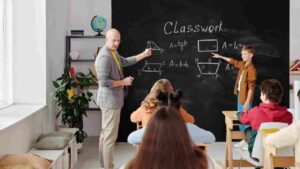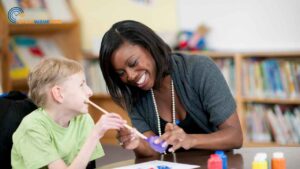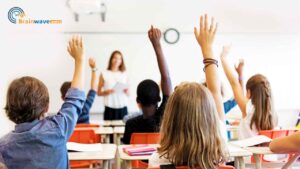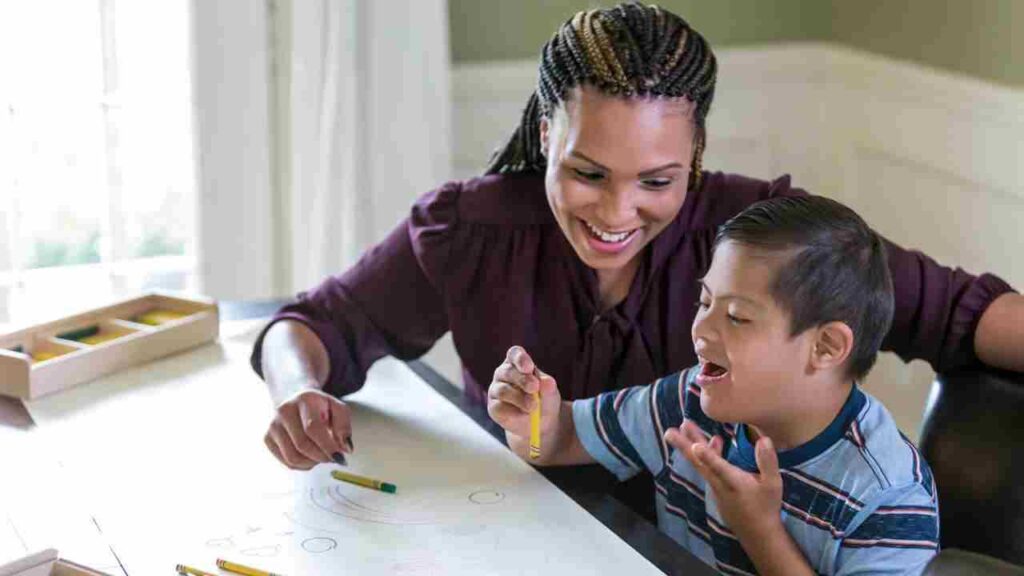Discover effective strategies to successfully teach special needs, students. Get the tips and techniques needed to create a positive learning environment that encourages students to reach their full potential.
Assessing the Needs of Special Needs Students
Assessing the needs of special needs student is an important step in creating a successful teaching program. It is important to identify any challenges that a student may be facing and to develop an appropriate course of action to address these challenges.
This can be done through interviews, observation, and assessment of the student’s academic and social-emotional skills. It is essential to develop a comprehensive plan of action that can be implemented in a way that allows the student to reach their maximum potential.
Once the needs of the student have been identified, it is important to communicate this information to the appropriate personnel and to make sure that all belief in the plan for the student. It is only through this type of collaboration that positive results can be achieved.
1. Functional Behavioral Assessments

The process of conducting FBA involves capturing data from the student’s environment, such as observations and interviews, to determine the purpose and function of a student’s behavior. This data can then be used to identify the best strategies to help the student achieve their academic, social, and behavioral goals.
In order to ensure successful outcomes, FBA must be conducted in an ethical, respectful, and culturally competent manner. This includes developing positive and trusting relationships with the student, their family, and relevant professionals.
Information gathered in the assessment process needs to be valid, reliable, and supportive in order to ensure accuracy. Gathering data from multiple sources, such as family members, teachers, and other professionals, is important to provide a comprehensive understanding of the student.
The next step in this process involves developing a hypothesis about why a student is engaging in the behavior. This hypothesis is then tested through functional analysis. This process helps to identify antecedents or the events and conditions that occur prior to the behavior, as well as the consequences that result from the behavior.
After the analysis is complete, a plan can be developed to help modify the student’s behavior to meet their needs and the educational standards.
Overall, FBA is a valuable tool in the successful teaching of special needs students. It can help identify the factors that are contributing to a student’s behavior, which can then be used to create behavior support plans that are tailored to their individual needs.
By gathering data from multiple sources, developing hypotheses, and conducting a functional analysis, effective FBA can help ensure positive outcomes for special needs students in their educational setting.
Read also: Implementing Special Needs Education: Essential Strategies
2. Educational Assessments
Educational assessments are an essential part of teaching special needs students. They provide the teacher with invaluable insight into the student’s individual learning strengths and weaknesses, which in turn allows teachers to construct specialized instruction that is tailored to the student’s specific needs.
When working with special needs students, it is important to ensure that the assessments used are appropriate and that they provide the most accurate picture of the student’s skills and abilities.
Before beginning any assessments, it is essential to set up a system of communication with the student and the family.
This is important for two reasons: first, it allows the teacher to gain an understanding of the student’s learning environment, which may provide clues as to how best to assess the student; second, it provides the teacher with an opportunity to discuss the assessments and their results with the student and family.
Once the communication system is in place, the next step is to select the most appropriate assessment tool for the student. Generally speaking, it is best to use a combination of both informal and formal assessments when working with special needs students.
Informal assessments might include observations, interviews, and questionnaires, while formal assessments can include standardized tests and other more in-depth assessments. Whichever type of assessment is chosen, it is important to ensure that it is age and ability appropriate and that it is administered in a manner that is comfortable for the student.
Once the assessment is complete, the results must be interpreted in order to determine the student’s educational needs. Again, the results should be discussed with the student and the family in order to ensure that the needs are met in the most effective way possible.
It is also important to ensure that the results of the assessment are documented and regularly monitored so that any changes can be detected quickly and addressed accordingly.
Ultimately, educational assessments are an invaluable tool for teachers when it comes to teaching special needs students. They provide the teacher with the information that they need to create an effective and efficient learning environment for their students, and they also allow the teacher to monitor the student’s progress and ensure that they are receiving the best possible education.
Read also: What Are the Main Difficulties of Students With Autism?
Developing Individual Education Plans (IEPs)

IEPs are an important part of providing personalized learning that caters to the individual needs of special needs students. They help teachers set and track progress, ensure that every student is making progress, and provide an easy way to communicate with parents and other stakeholders.
IEPs can help ensure the goals and objectives are aligned with the Common Core Standards. Developing Individual Education Plans is a crucial step in the successful teaching of special needs students.
1. The Process of Developing an IEP
When it comes to providing the best educational experience possible for special needs students, developing an Individualized Education Program (IEP) is essential.
An IEP is a written document outlining a student’s special educational needs and goals, as well as the strategies and services that will be provided in order to meet those needs and goals. Developing an IEP requires a collaborative effort between parents, school personnel, and other professionals, such as medical experts.
Developing an IEP begins with a comprehensive evaluation, which is used to determine the student’s functional strengths and needs, as well as the best strategies for meeting those needs.
Once this evaluation is completed, a team of professionals meets to discuss the results and develop an appropriate IEP for the student. This team includes the student’s parents, the student’s teacher(s) or other school staff, representatives from the district, and other professionals who have conducted an evaluation of the student.
The IEP team is responsible for discussing the student’s goals and objectives, as well as the methods, strategies, and services that will be used to support them. It is essential that all team members stay focused on what is best for the student, and are willing to collaborate and compromise when needed.
During the development process, all team members should take into account the student’s strengths, weaknesses, and interests, in order to ensure that the IEP is both achievable and beneficial.
Once the IEP has been created, it should be reviewed regularly to make sure it is being properly implemented. The review process should include feedback from the student and their parents, as well as teachers, district representatives, and other professionals.
This is an important step as it helps to ensure that the IEP is meeting its intended purpose and that all team members are in agreement about its goals and strategies. If a particular strategy is not working or needs to be adjusted, the appropriate changes can be made during the review process.
Developing an IEP is a complex process that requires a great deal of collaboration and communication. It is important that all involved parties understand the importance of this process and work together to create an IEP that is in the best interest of the student.
Read also: Working With Special Needs: Strategies & Techniques
2. Components of an IEP
An Individualized Education Program (IEP) is an important component in the successful teaching of special needs students.
An IEP is a legal document that outlines the educational plan for a child with disabilities, as identified by an Individualized Education Plan Team. It is designed to ensure that each student receives the appropriate instruction and services needed for them to reach their individual academic goals.
When creating an IEP, the team must include the student’s parents or guardians, the primary teacher, at least one special education teacher, and other professionals who understand the student’s needs. The IEP should be updated yearly and include the following components:
• The present level of performance: The present level should include a description of the student’s current academic, social, behavioral, and other functional needs as well as an idea of how these areas contribute to the student’s educational progress.
• Measurable annual goals: The IEP should include a set of goals and objectives that are tailored to the student’s individual needs. These measurable goals should be specific, attainable, and meaningful.
• Transition planning: Transition plans provide students with the skills and resources necessary to make a successful transition from school to adulthood. Transition plans should include instruction in self-advocacy and decision-making, as well as planning for post-secondary education or employment.
• Special education services: The IEP should describe the necessary special education services or therapies that the student must receive in order to make progress. These services could include counseling, tutoring, speech therapy, occupational therapy, and specialized instruction.
• Accommodations and modifications: Accommodations are changes in the environment, materials, or procedures that enable a student with disabilities to access the general curriculum. Modifications are changes to the instructional level or expectations for a student with disabilities. Both accommodations and modifications should be written into the student’s IEP.
Creating an effective IEP is essential in ensuring that special needs students are provided with the support and instruction they need to make progress in the classroom. The components of an IEP should be tailored to the individual student’s needs and should be updated each year to reflect the student’s current level of performance.
Teaching Strategies for Special Education Students

1. Create a safe and secure learning environment: Create an environment that is conducive to learning, where the student feels confident and supported.
2. Learn the student’s strengths and weaknesses: Take the time to get to know each student, as well as their strengths and weaknesses. This will help you understand how best to meet their unique needs.
3. Use various teaching tools: Incorporate multiple teaching techniques, such as visual aids and verbal instruction, to ensure that all students understand the material.
4. Develop relationships with students: Building positive relationships with students can help build trust and make them more comfortable to learn.
5. Offer positive reinforcement: Praise students for their successes and encourage them to keep trying.
These strategies can help create an atmosphere of learning and success for students with special needs. With the right approach, special education students can make great progress in their studies and find success in their education.
1. Incorporating Technology
In the past, teaching students with special needs often required different strategies than those used in regular classrooms. However, with the advances in technology, teachers today have many more tools at their disposal to help special needs students succeed.
Incorporating technology into the curriculum can make a big difference in the learning experience for students with special needs and open up possibilities that weren’t available in the past.
One of the most beneficial tools available is adaptive software, which can be used to adjust the difficulty level of course material to fit the individual needs of special needs students. This type of software adjusts readings, quizzes, and other activities so that students can work at a level that’s appropriate for them.
This not only encourages students to take responsibility for their learning but also allows them to work independently and at their own pace.
Technology can also be used to simplify the process of teaching material. Assistive devices such as switches and voice-activated software can be used to help students with cognitive impairments access the material more easily.
Augmentative and Alternative Communication (AAC) devices can also be used to support low-functioning communication and literacy skills. These devices can be controlled by a single switch, joystick, or pointing device, allowing students to operate them with minimal support.
Another way to incorporate technology in the classroom is to use video conferencing to connect special needs students to other classrooms. This can allow students to form peer relationships and have access to activities that they may not have been able to participate in without the use of technology. Furthermore, video conferencing can also be a great way for teachers to collaborate and share ideas.
Technology can also help students with disabilities complete assignments and projects. For instance, dictation software or text-to-speech programs can be used to help students write papers, reports, or essays. Additionally, virtual reality (VR) simulations can be used to help students with physical disabilities practice motor skills or practice activities that may be difficult for them to complete in person.
Technology can also be used to provide extra support and guidance to special needs students. For instance, tutoring software can provide students with personalized instruction and feedback.
Speech-recognition technology can also be used to help students better understand and process spoken language. With these tools, teachers can provide special needs students with the extra assistance they need to succeed.
Read also: Education Considerations for Students with Autism
2. Incorporating Visuals and Manipulatives
Incorporating visuals and manipulatives into classroom instruction is a powerful tool for successfully teaching special needs students.
Visuals and manipulatives provide concrete representations of abstract concepts, a critical learning tool for special needs students. It also gives them the opportunity to manipulate materials, providing a tactile learning experience that can help to reinforce understanding.
Visuals come in many forms, from pictures and photographs to diagrams and illustrations. They can help to connect the student to the content and can make abstract ideas concrete.
Manipulatives are the hands-on objects that students use to explore concepts in a physical way. These can include items such as coins and bills, geometric shapes, counting cubes, and anything that can be used to teach a variety of math and science concepts.
Incorporating visuals and manipulatives into special needs instruction can help to make learning fun and engaging. Using manipulatives, teachers can create interactive tasks to draw students into the learning process.
For example, a teacher can use coins and bills to show students how to count change or geometric shapes to demonstrate the concept of area. With visuals, students can explore relationships between objects, create diagrams to show understanding, or illustrate the structure of a process.
In addition to giving special needs students a tangible way to interact with the material, visuals and manipulatives can help to increase student engagement. Research has shown that students with special needs tend to be more motivated by visual cues and when they can manipulate materials.
For these students, having the opportunity to manipulate objects can help to make the content more interesting and can help to increase motivation.
Incorporating visuals and manipulatives is an important part of successful instruction for special needs students. By creating engaging, tactile learning experiences, teachers can help to foster a deeper understanding of the material and give students the opportunity to explore their learning in a hands-on way.
This can help to make learning more engaging, motivating, and enjoyable and can help to give special needs students the tools they need to succeed in the classroom.
3. Using Differentiated Instruction
Differentiated instruction is an important teaching strategy that can help special needs students to be successful. It is a way to individualize instruction to accommodate the different learning styles, strengths, and interests of each student. It also promotes student engagement, which is key to student success.
Differentiated instruction can be achieved by providing various learning activities that focus on the same concept or topic. For example, the teacher can provide three different reading passages related to a specific topic, allowing the student to choose the one they feel most comfortable with. This allows the student to access the material at their own level.
Another example of differentiated instruction is providing different learning tasks for different students. For example, some students may need more time on a particular activity and some may need less time. Some students may need different equipment and materials to complete activities. This ensures that each student is provided with the appropriate level of instruction.
Differentiated instruction also involves modifying the way in which the material is presented. For example, a teacher might provide visual aids, manipulatives, or audio recordings to help the student better understand the material.
This is especially important for special needs students who may need more time to process the material or may have difficulty understanding the content in a traditional way.
Another way to differentiate instruction is to provide students with a variety of activities to help them apply the material they have learned. For example, a teacher might provide a writing assignment, a lab experiment, or a problem to be solved. This allows the student to explore the concept in depth and to make connections between the material they have learned and the real world.
Differentiated instruction is an important part of successful teaching for special needs students. By providing different learning activities that focus on the same concept or topic, modifying the way in which the material is presented, and providing students with a variety of activities to help them apply the material, special needs students will have access to the material at their own level and be more engaged in the learning process.
4. Adapting Curriculum
Adapting curriculum for special needs students is critical to their success in the classroom. While the teacher’s approach must be adapted to each individual student’s needs, there are several strategies that can be used to ensure that all students understand and engage with the material.
One approach is to use individualized instruction plans tailored for each student. This allows for differentiated instruction, meaning the teacher can build on each student’s strengths and interests while also addressing their unique needs.
It can be helpful to break down tasks into manageable chunks and to use visual aids and hands-on activities. These can help to capture the student’s interest and to reinforce the concepts being taught. Finally, it is important to ensure that the curriculum is accessible to all students, including those with physical or cognitive disabilities.
By taking the time to plan and adjust the curriculum, teachers can ensure that all students are provided with appropriate learning materials and activities.
Conclusion
The teaching of special needs students can often be a challenging process, but one that can lead to great success. To ensure success, it is important for educators to understand what special education is, assess the needs of their students, and develop individual education plans (IEPs).
Educators should also use a variety of teaching strategies to help special needs students learn, such as adapting curriculum, incorporating technology, utilizing visuals and manipulatives, and using differentiated instruction. With the implementation of these strategies, educators can be sure that special needs students receive the best education possible.
It is important to provide special needs students with the necessary tools to build confidence, self-esteem, and success in their learning. With the right support and instruction, special needs students can have the same opportunities as all other students to achieve greatness.







